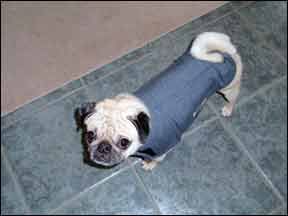The article on homeowners’ and renters’ insurance (“No Insurance,” Whole Dog Journal’s June 2011) listed Amica as one of the “good guys.” We had Amica insurance for 22 years for our home and car. We rescued a Pit Bull a year ago and we live in Ohio, so we needed the added dog liability insurance. When we called Amica, they asked about the dog. He (Dillon) has no bite history, goes to the vet, lives with two other dogs, and completed his Canine Good Citizen (CGC). Our yard is fenced and Dillon stays in the house. Amica would not insure us. Farmer’s Insurance did, however.

288
Judy Butler
Wickliffe, OH
Thanks for the feedback. The more that dog owners share their especially good and especially bad experiences with insurance companies, the better we can identify the ones to recommend to our dog-owning friends – and warn them away from the ones that discriminate against certain types of dogs.
When I saw the article in the June issue about noise fear (“Can’t Avoid Noise”), I read it immediately. My dog Lucy is terribly afraid of thunderstorms. She barks, runs back and forth, and gets almost hysterical. I should say, she used to do those things. We tried counter-conditioning and desensitization, drugs, etc. Nothing worked.
Then our vet asked if we had ever heard of the Thundershirt. We had not. I checked the website (thundershirt.com) and decided to give it a try. It should be renamed! I call it the miracle shirt. The very first time we had a bad storm, I put the shirt on Lucy and she showed zero anxiety. She slept like a baby. I thought it was too good to be true. The next time, same reaction. Please look at the website and believe what it says. It has made a huge difference in our lives during noise events.
This product is truly remarkable. I hope that you will consider checking it out yourself and mentioning it in a future issue. It is so much better than using a drug.
Sandra Henry
via email
Regarding “Diet Upgrade” in the May issue: I add warm water to my dog’s dry food. I tried it when Leo was hungry on his smaller, weight-loss portion of food. He was so hungry right after he ate that he would swat the bag of kibble with his paw as if I had short-changed him!
I had considered switching Leo to the canned version of his food because it was more volume and weight for the calories, but it was almost four times the price. I just could not afford it. The main ingredient difference was that the canned food had chicken broth, and the dry food’s bag suggested adding warm water to release the aromas. I decided to try it.
I use a large flat-bottom bowl divided into seven “pie” wedges (to make my dog eat slower), so his kibble is all in one layer. I cover that layer with warm (not hot) water and let it sit on the counter for two minutes. Most of the water is absorbed by the kibble, making each piece swollen to roughly twice its dry size. My dog is happy and spends a lot more time eating his food. No more swatting the bag with his paw. What is interesting to me is that he is better hydrated, too. His urine is a lighter color and he produces a larger volume, too. Despite my offer of fresh water at all times, he must not have been drinking enough. Hydration is necessary for humans to burn fat, and maybe it’s true for dogs. For that reason, I will continue adding water to his food even after he loses weight.
Jenny Rellick
Via email
Adding water to dry food does really increase its palatability for many dogs, and the increased hydration is beneficial. Plus, as you learned, it helps a hungry dog on a weight-reduction diet to feel full. Our only concern would be for dogs who don’t finish their food in a short period of time. Adding water sets up the perfect condition for bacterial growth, so this wouldn’t be suggested for a dog who picks at his food for hours at a time.
I’ve been considering asking for a titer test in lieu of giving annual shots. I asked my vet about it and he said I’m the first person to ask him about it! (We live in a small town in a rural area). He said he would find out the costs and get back to me. Unfortunately, in our area folks are more concerned with costs than care. He called today to tell me he’d be glad to do it, and that the only thing to test for is distemper since the rabies is required by law.
Is the distemper all he should check? Also, he recommended a three-year rabies vaccination instead of a one-year booster. Do I want this? My dogs are 1 and 9 years old.
Jeana Swift
Via email
Hi Jeana! Great job for questioning the status quo and helping bring your vet up to date! Please refer to “Overvaccination: Dog Owners Beware” in Whole Dog Journal’s August 2010 issue; it should answer your questions completely. (You know that current subscribers have free online access to all back issues, right?) In brief: The best titer test to order checks the dog’s antibody levels for distemper and parvovirus; any positive result suggests your dog’s immune system responded properly to his previous vaccinations and has sufficient immune memory needed to combat the diseases if he encounters them. Rabies vaccination is required by state law, and we do suggest the three-year vaccine after the dog’s first year.






